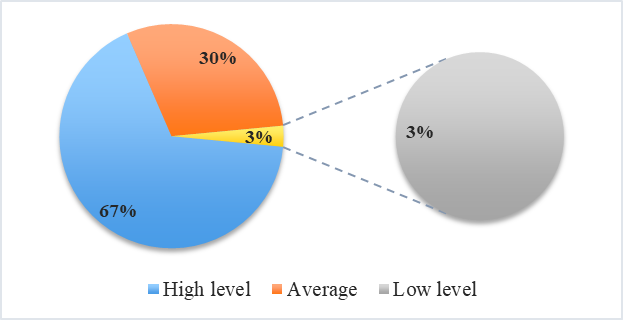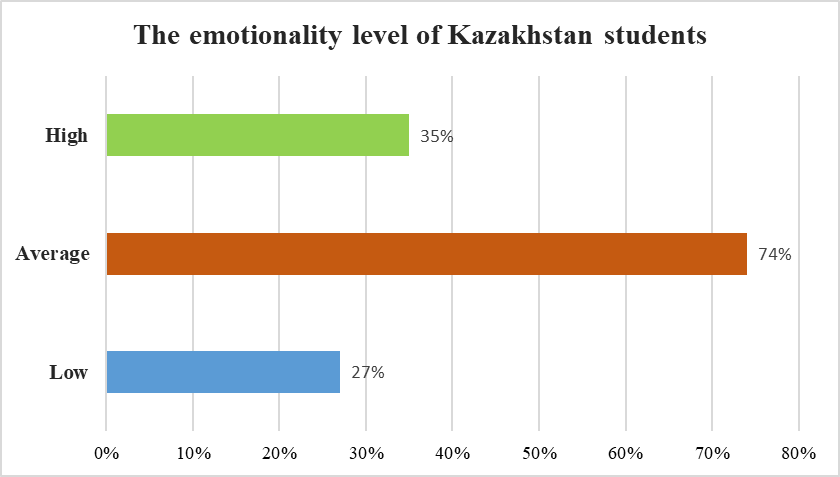Abstract
The present paper measures the interconnection between religiousness and emotionality among Kazakhstan students. In fact, according to John Corrigan (
Keywords: Emotionreligiousnessstudents
Introduction
Kazakhstan has historically hosted a wide variety of ethnic groups with varying religions. The foundation of an independent republic, following the disintegration of the USSR, has launched a great deal of changes in every aspect of people's lives. Religiosity of the population, as an essential part of any cultural identity, has undergone dynamic transformations as well (International Religious Freedom Report, 2017). After decades of suppressed culture, the people were feeling a great need to exhibit their ethnic identity – in part through religion. Empirical research shows that for the first years after the establishment of the new laws, waiving any restrictions on religious beliefs and proclaiming full freedom of confessions, the country experienced a huge spike in religious activity of its citizens e
According to Glock and Stark (1965) within all world religions there are universal dimensions. They are ideological (beliefs), intellectual (knowledge or cognitive), ritualistic (traditional behaviour) and experiential (experiences defined as religious in the sense of arousing feelings or emotions), and consequential (application in the secular world). The idea of having religiousness activity among Kazakh youth in the sense of feelings and emotions is the issue of our interest.
Understanding psychologically religion, spirituality, and irreligion (for brevity, “religion”) as a domain of human life involving personality, cognition, emotions, and leading to social consequences is certainly a legitimate and important task for personality and social psychology. Research on this domain, innovative in both theory and methodology, has importantly developed in the last 15 years. People may experience and express their religious attitudes—positive or negative ones—somehow independently from their own or any religious culture (Flanagan & Jupp, 2007). Yet, people deal with religious beliefs, experiences, values, and communities that have been socially shaped and legitimated. Thus, the individual and social dimensions are related (e.g., Wolf, 2005). Emotion plays a fundamental role in religion. In the nineteenth and early twentieth centuries, theorists ranging from Friedrich Schleiermacher and Rudolf Otto to Emile Durkheim, Sigmund Freud, and William James attempted to define that role. Whether the emphasis was on the power of emotion to bind social collectives or on emotion in religion as “oceanic feeling” or “feeling of absolute dependence,” most writing about religion proceeded on the assumption that human emotionality was a constituent element of religious life. In the latter part of the twentieth century, theories of religion that emerged especially from the social sciences reiterated the claim that emotion was central to religion. In the work of Robert Bellah, Clifford Geertz, and, eventually, Rodney Stark, “feeling” of one sort or another was integral to religion (Bellah, 1970). But in these theories, and others of the time, emotion itself remained largely undefined. The present study focused on what religious variables were useful in predicting educational pursuit and either positive or negative educational perceptions among Kazakhstan students, because the religiousity level is tend to be very high among them.
Problem Statement
Religiousness is a complicated, integrative social-psychological characteristic. However, the issue of whether religiosity influences the emotional components of Kazakhstan students was investigated in our study.
Research Questions
Does religiousness as a socially-psychological virtue influence the self-attitude and emotional mood of students in Kazakhstan?
Purpose of the Study
The present study is based on the idea of Glock and Stark (1965) who have been influential in defining religious orientations, origins, and dimensions. The purpose of this study is to find out whether the components of religiousness among students in Kazakhstan has correlation with their emotionality during their academic activity.
Research Methods
This research study involved 136 students aged between 17 to 25 years attending a number of Kazakhstan universities. "The emotional level" questionnaire by Ilyin (2011), and the religiousity questionnaire by Suchkova (2009) were used to obtain the data to answer the research question.
Findings
Results of Religiousness level among Kazakh students
Descriptive statistics for the Religiousness level among students showed that 67% of students tend to accept themselves as a religious person, in comparison with the 30% and 3% of average and low level of religiousness respectively. The review revealed that a vast majority of the students exploring the relationship between religiosness and their emotionality during their academic activity (see figure

As seen in figure
The results of emotionality level among Kazakh students
The emotionality was tested via Suvorova’s "emotional level" questionnaire (Ilyin, 2011). As a result, over a third showed a low level of emotional expression, which probably indicated that they avoided remembering past emotional experiences; also over a third showed emotionality in middle range, and the rest had a high level of emotional expression (see figure

As it seen in figure
T-test analysis of Religiousness and emotionality among Kazakh students
The T-Test analysis revealed significant paired correlation (sig. 0.01**) between high and middle religiousness level and the same emotionality level among the students. The low level of researched scales didn't show any significant connections.
Conclusion
Measuring the religiousness and emotionality showed that the religiousness level among students of Kazakhstan is quite high, even if they don’t practice any religion the level of their religiousness is 67%. However the emotionality level seems to be in the average level. Significant correlation revealed between high and middle religiousness level and the same emotionality level among students of Kazakhstan. Thus, the idea of having the religiousness activity among Kazakhstan youth in the sense of feelings and emotions has theoretical and practical implementations. So answering the question: does religiousness as a socially-psychological virtue influence to the self-attitude and emotional mood of students in Kazakhstan, the results of present study shows-yes it does. There are significant interconnection beetween religiousness level and the same emotionality level among students of Kazakhstan.
Acknowledgments
Heartfelt thanks to the valued study subjects, who participated in the process of study despite their academic activity.
References
- Bellah, R. (1970). Beyond Belief: Essays on Religion in a Post‐traditional World. New York, NY: Harper and Row.
- Corrigan, J., Crump, E., & Kloos, J. (2000). Emotion and Religion: A Critical Assessment and Annotated Bibliography. Westport, Conn.: Greenwood Press. (pp. 121–74) “Theological Studies.”
- Flanagan, K. & Jupp, P. C. (Eds.). (2007). A sociology of spirituality. Burling- ton, VT: Ashgate.
- Glock, C. Y. & Stark. R. (1965). Religion and society in tension. Chicago: Rand McNally.
- Ilyin, Е. P. (2011). Emotion and feelings. St.Petersburg:
- Kazakhstan – International Religious Freedom Report (2017). Retrieved from doi: https://www.state.gov/documents/organization/281268.pdf
- Wolf, C. (2005). Measuring religious af liation and religiosity in Europe. In J. H. P. Hoffmeyer-Zlotnik & J. Harkness (Eds.), Methodological aspects in cross-national research (ZUMA-Nachrichten Spezial 11) (pp. 279–294). Mannheim: ZUMA.
- Suchkova, O.V. (2009). Social-psychological aspects of religiousness among youth. St.Petersburg.
Copyright information

This work is licensed under a Creative Commons Attribution-NonCommercial-NoDerivatives 4.0 International License.
About this article
Publication Date
14 January 2019
Article Doi
eBook ISBN
978-1-80296-052-5
Publisher
Future Academy
Volume
53
Print ISBN (optional)
-
Edition Number
1st Edition
Pages
1-812
Subjects
Education, educational psychology, counselling psychology
Cite this article as:
Tolegenova, A., Duanayeva, S., Summers, D., Zholdassova, M., & Kapasova, D. (2019). Emotional Components Of Religiousness Among Students In Kazakhstan. In Z. Bekirogullari, M. Y. Minas, & R. X. Thambusamy (Eds.), ICEEPSY 2018: Education and Educational Psychology, vol 53. European Proceedings of Social and Behavioural Sciences (pp. 444-448). Future Academy. https://doi.org/10.15405/epsbs.2019.01.42

